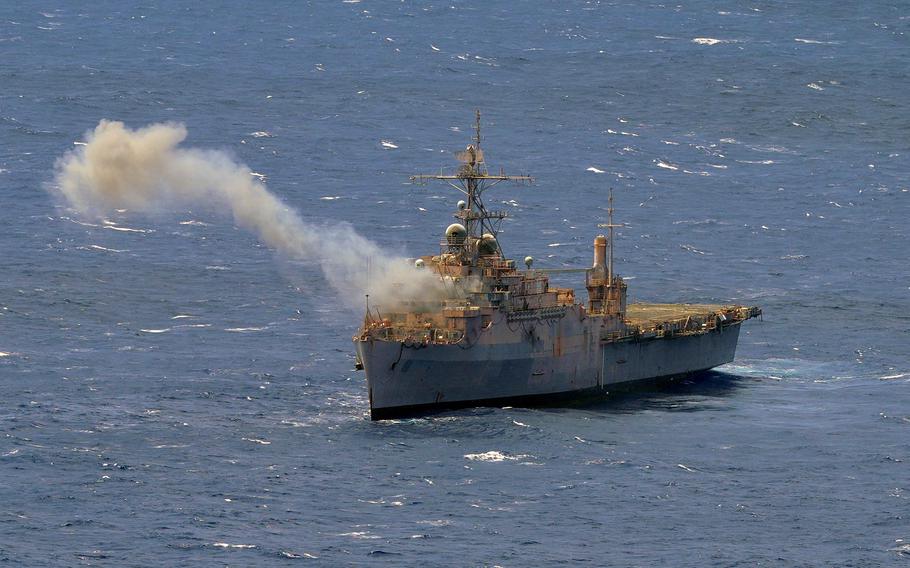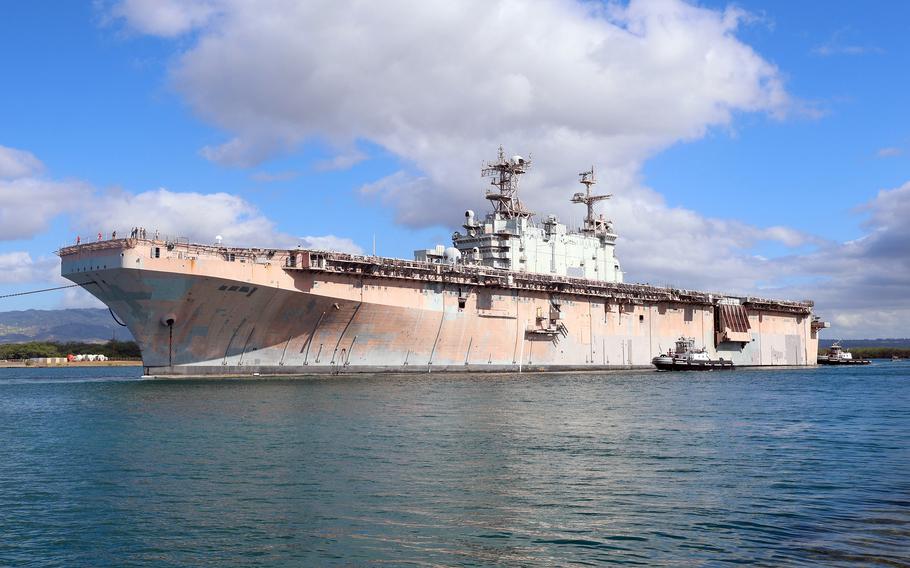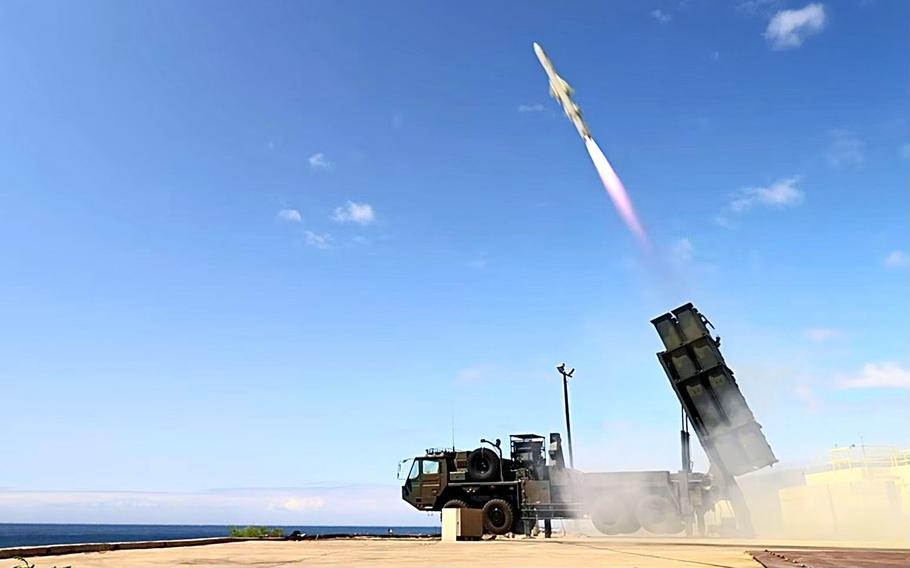
The decommissioned amphibious transport dock USS Dubuque smokes after taking a direct hit with a missile off Hawaii during the Rim of the Pacific exercise on July 11, 2024. (Perla Alfaro/U.S. Army)
FORT SHAFTER, Hawaii — The biennial Rim of the Pacific maritime exercise ended its six-week run Thursday in Hawaii, a span that included the sinking of two decommissioned warships by numerous weapons systems wielded by a multinational force.
The exercise, which began in late June in waters off Hawaii, is touted as the world’s largest international series of naval drills.
Twenty-nine nations participated this year’s RIMPAC, which included 40 ships, 150 aircraft, three submarines, 14 land-based armed forces and 25,000 personnel.
The sinking of two warship “hulks” is twice the number sunk in previous RIMPAC exercises.
The decommissioned USS Dubuque, an amphibious transport dock, was sunk July 11. A week later, the 820-foot-long former USS Tarawa, an amphibious assault ship the size of a small aircraft carrier, was sunk July 19.
The ships went down in waters 15,000 feet deep about 50 nautical miles off the northern coast of Kauai, the westernmost island in the Hawaiian chain.

The decommissioned USS Tarawa, an amphibious assault ship, is escorted out of Pearl Harbor to the open sea during the Rim of the Pacific exercise on July 16, 2024. (Courtney Strahan/U.S. Navy)
“Using advanced weapons and seeing the professionalism of our teams during these drills shows our commitment to keeping the Indo-Pacific region safe and open.” Vice Adm. John Wade, commander of the exercise’s Combined Task Force and of 3rd Fleet, said in a July 23 news release.
The release makes no mention of China in describing the “long-planned” sinking exercises, but that nation’s growing military might is regarded by the Pentagon as America’s “pacing challenge.”
One aspect of the sinking exercise demonstrated that warships anywhere in the world could be vulnerable to a quick and devastating attack by U.S. forces in the event of a conflict.
In a test dubbed Quicksink, an Air Force B-2 stealth bomber delivered a guided bomb on the Tarawa, which displaced 38,900 tons.
The demonstration proved that the B-2 provides a “low-cost, air-delivered method for defeating surface vessels,” the Navy said in its release.
The official China Military Online took note in a July 24 article by Yang Zhen, the deputy director of the Northeast Asia Research Center, Shanghai University of Political Science and Law. Zhang wrote that this year’s RIMPAC clearly aimed to demonstrate the joint forces’ ability to target Chinese assets.
China’s Type 075 amphibious assault ship has a displacement similar to the Tarawa, and some countries participating in the exercise “didn’t bother to conceal the fact that RIMPAC 2024 is highly targeted at China, which has surprised many,” Zhang wrote.

Japanese soldiers fire a Type 12 surface-to-ship missile during a Rim of the Pacific sinking exercise on Kauai, Hawaii, on July 12, 2024. (Perla Alfaro/U.S. Army)
Quicksink was funded by the Office of the Under Secretary of Defense for Research and Engineering and aimed “to provide options to neutralize surface maritime threats while demonstrating the inherent flexibility of the joint force.”
Given the B-2’s stealth, range and payload capacity, the bomber could play a significant role in any future naval conflict with China. It can fly 6,000 miles without refueling, cruise about 560 mph at 50,000 feet and carry roughly 50,000 pounds of bombs.
“This capability is an answer to an urgent need to quickly neutralize maritime threats over massive expanses of ocean around the world at minimal costs,” the Navy news release states.
A Navy F/A-18 jet also hit the Tarawa with a Long-Range Anti-Ship Missile, or LRSAM, which the news release described as “a precise, stealthy and survivable cruise missile.”
The missile carries a 1,000-pound warhead and can reach targets more than 200 miles distant.
Air Force B-1B bombers also routinely deploy with LRSAMs.
U.S. Army units teamed with the Japan Ground Self-Defense Force’s 5th Surface-to-Ship Field Artillery Regiment to sink the Dubuque, the Army said in a July 11 news release.
The Army’s 1st Multi-Domain Task Force fired on the ship using High Mobility Army Rocket System, or HIMARS, launchers deployed at Pacific Missile Range Facility Barking Sands on Kauai.
The Japanese forces fired on the ship from the same location with Type 12 surface-to-ship missiles, the Army news release states.
Units from Australia, Malaysia, the Netherlands and South Korea also participated in the sinking exercise.
“The power of RIMPAC is in how it strengthens relationships between participating nations by challenging us to conduct realistic and relevant training together,” Royal Australian Air Force Air Commodore Louise desJardins, commander of the exercise’s Combined Force Air Component, said in the news release.